
Instead of Joint Sword-2024C, PLA Intensifies Winter Naval Training
Publication: China Brief Volume: 24 Issue: 24
By:
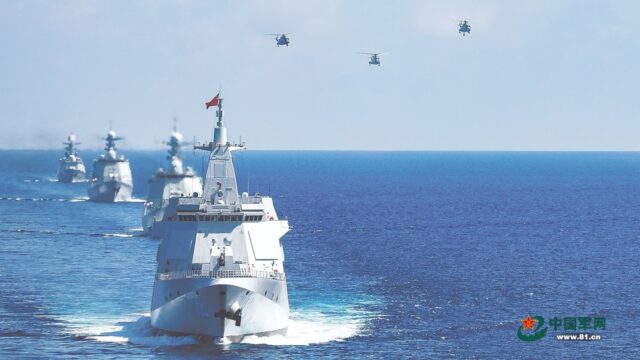
Executive Summary:
- People’s Liberation Army (PLA) naval training drills near Taiwan and surrounding the First Island Chain on December 9–11 did not constitute a full-scale joint exercise but sent a signal to the incoming US administration.
- Beijing’s power projection demonstration, involving 60 vessels, signals to President-elect Trump that its naval capabilities in the Western Pacific are comparable to those of the US Seventh Fleet based in Japan.
- The PLA Navy appears to be intensifying its winter naval training around the waters of the First Island Chain, sustaining a sizeable naval presence over eight consecutive days. Coast Guard involvement indicated a possible circumnavigation of Taiwan.
- Taiwan’s mobilization seems precautionary rather than a response to an immediate threat, with its Ministry of National Defense establishing a response center and mobilizing forces to maintain a heightened state of readiness.
On December 9, Taiwan’s Ministry of National Defense (MND) publicly announced that the People’s Republic of China (PRC) had designated seven areas east of Zhejiang and Fujian as temporarily reserved airspace (MND, December 9). At first, there was confusion over the nature and scale of the PRC activities. A senior Taiwanese security official stated that about 90 People’s Liberation Army Navy (PLAN) and China Coast Guard (CCG) vessels were operating around the First Island Chain—a record number—while an anonymous US official stated that the scale instead was consistent with previous activities (Reuters, December 10; 11).
The latest drills, which occurred on December 9–11, were not another iteration of the “Joint Swords” exercises. [1] Instead, they appear to have been training drills (演訓), not only involving training (訓練) but also certain scenario simulations aimed at strengthening the PLAN’s winter far-sea operational capabilities. They also appear to signal to US President-elect Trump’s incoming national security team that the two navies possess comparable capabilities in the Western Pacific.
Latest Training Drills See Sustained Naval Presence Encircling Taiwan
Three important observations from the recent training drills concern the relatively small number of aerial sorties that took place, the sustained presence of a large number of naval vessels in waters surrounding Taiwan, and the involvement of CCG patrol vessels circling the island.
First, the number of PLA aircraft sorties crossing the median line, both in absolute terms and as a proportion of all sorties, was significantly lower than during previous military exercises targeting Taiwan. Total daily sorties detected over the three days were 47, 53, and 34, respectively, with those crossing the median line accounting for 34 percent, 43 percent, and 64.7 percent of total sorties, according to data released by Taiwan’s Ministry of National Defense. A comparison of these numbers with those from other events in 2024 is shown in Figure 1 (MND, May 24, 25, October 15, December 8, 9, 10, 11, 12, 13, 14).
The degree of immediate threat posed by the daily sorties announced by Taiwan’s Ministry of National Defense varies. The most immediate and severe threats come from the sorties that cross the median line and fly close to Taiwan’s 24-nautical-mile contiguous zone, as Taiwan’s military would have barely any time to react. The second-most immediate threat comes from aircraft that cross the median line but operate within Taiwan’s southwestern waters and airspace. These aircraft are further from the 24-nautical-mile contiguous zone, providing Taiwan with relatively more reaction time. The lowest level of immediate threat comes from aircraft that do not cross the median line and operate outside the northern and southern ends of the strait and in the airspace on the northernmost and southwestern edges of Taiwan’s air defense identification zone. This distinction explains why the Ministry of National Defense only disclosed the number of aircraft that crossed the median line before August 2022.
Figure 1: Trends in PLA Sorties Around Taiwan
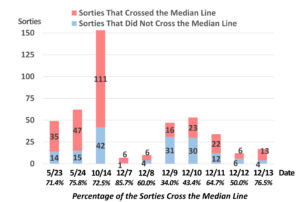
(Source: Compilation by RCDA Based on ROC MND Press Releases)
In the December training drills, relatively few sorties approached Taiwan’s adjacent airspace and could be deemed immediate threats. The daily number of sorties operating in the southwestern airspace averaged 15. [2] Beyond these, PLA Air Force (PLAAF) sorties approaching Taiwan each day numbered 1, 8, and 6, accounting for 2.1 percent, 15.1 percent, and 17.6 percent of total sorties, respectively. Flight paths are illustrated in Figure 2, and the trends are shown in Figure 3.
Second, the number of PLAN vessels operating near Taiwan has increased and persisted for several days. The number of PLAN vessels in waters surrounding Taiwan exceeded 10 each day during the drills, with 12, 11, and 16 ships observed, respectively (MND, December 10, 11, 12). This number is equivalent to nearly half the total number of destroyers and frigates that Taiwan’s Navy can routinely deploy at any given time, imposing considerable strain on Taiwan’s training, logistics, maintenance, and personnel rotation. [3] In response, all first-class warships—Taiwan’s main combat vessels—stationed at Zuoying Naval Base were deployed on December 10, according to Taiwanese media reports (UDN, December 10).
For Taiwan, the number of PLAN vessels present in its surrounding waters is a significant threat indicator. From December 5–12, the PRC regularly maintained a presence of over 10 naval vessels operating in waters around Taiwan (MND, December 6, 7, 8, 9, 10, 11, 12, 13, 14). In other words, the PLA sustained significant naval pressure on Taiwan for almost eight consecutive days. This is not the first instance of such high-intensity naval coercion by the PLA. For example, the PLA deployed more than 10 naval vessels in the vicinity of Taiwan almost every day over the period of August 12–19 this year (MND, August 13, 14, 15, 16, 17, 18, 19, 20).
Third, many CCG vessels were present in waters around Taiwan for prolonged periods and successfully carried out extensive patrols circling the island. Taiwan’s Coast Guard Administration announced that starting December 6, the CCG deployed three vessels to conduct patrols in waters east of Taiwan (CGA, December 10). On December 9, four additional vessels were dispatched through the Taiwan Strait toward waters southwest of Taiwan. While Taiwan’s Ministry of National Defense announced the establishment of an emergency response center on December 9, the Coast Guard Administration had already set up such a center on December 6 to address the unusual CCG activities.
Figure 2: Flight Paths of PLA Aircraft Activities Around Taiwan on December 9–11
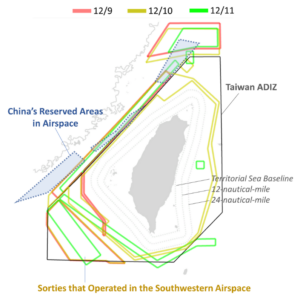
(Source: Compilation by RCDA Based on ROC MND Press Releases)
A total of nine CCG vessels operated around Taiwan. These included the 2203, 2302, 2304, and 2307 vessels, which initially operated in Taiwan’s southwestern waters before sailing to its eastern waters, as well as the 2901, 1301, and 1302 vessels and two additional Coast Guard ships (CNA, December 13). These vessels finally departed Taiwan’s eastern waters between December 12 and December 13, sailing northward. The closest approach of the CCG to Taiwan’s coastline was 36.7 nautical miles, and none of the vessels entered Taiwan’s 24-nautical-mile contiguous zone (LTN, December 14).
Naval Drills Focused on First Island Chain
As of December 10, approximately 60 PLAN vessels were operating near Taiwan, the southern Japanese islands, and the East and South China Seas, according to information disclosed by anonymous Taiwanese officials (Reuters, December 10). No further details about the distribution of these vessels across the various waters are currently available. The following two observations are based on publicly accessible information.
First, at least 12 PLAN vessels were operating in the Philippine Sea, potentially circumnavigating Taiwan. According to data from Japan’s Ministry of Defense Joint Staff, 14 PLAN vessels passed through waters near Japan’s southwestern islands within a month before December 9, with most movements concentrated between November 27 and December 12 (Joint Staff, November 27, 28 [1], [2], December 2, 4, 6, 9, 11, 12). Of these vessels, 12 were likely part of the PLA’s activities on December 9–11 (the Type 054A frigates with hull numbers 542 and 548 returned to the East China Sea before December 1). This is a conservative estimate, as the data from Japan’s Ministry of Defense only accounts for vessels transiting through the southwestern Japanese islands and does not include those entering or exiting the Philippine Sea via waters between Taiwan and the Philippines. Details of specific PLA Navy vessels are listed in Table 1.
Figure 3: Trends in PLA Sorties Around Taiwan Over December 9–11
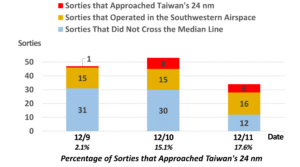
(Source: Compilation by RCDA Based on ROC MND Press Releases)
Among the 12 vessels, most entered the Philippine Sea from the East China Sea between December 4 and December 7 and returned to the East China Sea between December 11 and December 12. They primarily exited the East China Sea through the Miyako Strait, part of Japan’s Ryukyu Islands, and the Osumi Strait, near Japan’s Kyushu Island. All returning vessels, however, navigated through the Miyako Strait, which is closer to Taiwan.
A potential circumnavigation of Taiwan may have involved eight PLAN vessels. The Type 052C destroyer with hull number 153, the Type 052D destroyers with hull numbers 135, 154, and 155, and the Type 054A frigate with hull number 577 are only recorded by Japan’s Ministry of Defense Joint Staff departing the East China Sea. Conversely, the Type 054A frigate with hull number 534 and the Type 056A corvettes with hull numbers 608 and 615 are only recorded entering the East China Sea from the Philippine Sea. A single recorded entry into or exit from the waterways of Japan’s southwestern islands suggests that these vessels may have passed through the waters between Taiwan and the Philippines. Most of these ships are based at ports along the coasts of Zhejiang and Fujian Provinces under the PLAN’s Eastern Theater Command, implying a possible circumnavigation of Taiwan. A potential route could involve departing from the homeport in Zhejiang, transiting through the East China Sea, the waterways of Japan’s Southwestern Islands, the Philippine Sea, the Bashi Channel between Taiwan and the Philippines, the South China Sea, the Taiwan Strait, and back to the East China Sea before returning to the homeport in Zhejiang. Alternatively, the sequence could be reversed.
Second, the frequency of PLA aircraft activity was significantly reduced compared to naval operations. According to information released by Japan’s Ministry of Defense, a Y-9 aircraft and a drone flew from the East China Sea to the Philippine Sea on December 9 and 10, respectively (Joint Staff, December 9, 10). Meanwhile, Taiwan’s Ministry of National Defense (MND) reported that one PLA aircraft and one drone flew from the Bashi Channel to the Philippine Sea on December 11 (MND, December 12). Their flight paths indicate they may have been part of a pattern training drill coordinated with PLAN vessels. The minimal PLAAF involvement, however, fell short of the scale expected for a joint exercise. A clear contrast can be seen in the PLAAF’s long-distance training drill on November 30, when 12 PLA aircraft and 2 Russian aircraft flew through the Miyako Strait into the Philippine Sea (Joint Staff, November 30). A comparative chart is shown in Figure 4.
Table 1: Maneuvers of PLA Naval Vessels Through Japan’s Southwestern Islands Waterways
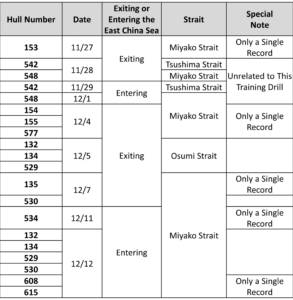
(Source: Compilation by RCDA Based on Press Releases of Japan’s Ministry of Defense Joint Staff)
The PRC government did not announce the activities on December 9–11 as a military exercise, indicating that they were not intended as a fourth iteration of the “Joint Sword” exercises. The training drills instead focused on naval vessel operations and simulations, with naval formations conducting separate exercises in different maritime areas, including the Philippine Sea, the East China Sea, the South China Sea, and waters surrounding Taiwan, rather than being part of a single large-scale military exercise.
The extent of “jointness” on show between the Navy and Air Force was limited. Aside from the two aircraft that entered the Philippine Sea from the airspace near Japan’s southwestern islands, only two aircraft were reported by Taiwan’s MND to have flown beyond the First Island Chain through the airspace between Taiwan and the Philippines, which occurred on December 11. This suggests that the training drill was likely primarily focused on the PLAN. Although Taiwanese officials have described the number of PLAN vessels as significant, the scale has not exceeded that of previous large-scale PLA military exercises, according to an unnamed US military official (Reuters, December 11).
PLAN Ships Rival US Seventh Fleet
There are two military implications from the recent drills. First, the PLAN has shifted from its usual practices to test and enhance its winter combat capabilities. Typically, after a year of military training and exercises, the PLA conducts fewer such activities during the winter months, with naval vessels sailing less frequently and in smaller numbers than in other seasons. This winter training drill, mobilizing most of the main combat ships of coastal Theater Commands and sustaining them for a week, breaks this norm. Naval forces from various theater commands now conduct far-sea training exercises even during the winter, enhancing their combat capabilities during this season.
Second, many of the proactive military preparations taken by Taiwan’s Ministry of National Defense aim to counter the PLA’s demonstrated potential capability to attack Taiwan as a necessarily precautionary measure. On December 9, the ministry swiftly established a response center and deployed many active-duty units to key areas (MND, December 9; UDN, December 10). These measures were taken in response to the PLA’s large-scale mobilization, which signals a potential capability to attack Taiwan rather than indicating an imminent crisis of attacking Taiwan. The PLAN’s presence around Taiwan, in the East China Sea to the north, the South China Sea to the south, and the Philippine Sea to the east, consisted of 60 warships. Under emergency orders from Xi Jinping, Chairman of the Central Military Commission, these vessels could converge around Taiwan within 24 hours. The PLAAF’s sorties near Taiwan were limited during these drills, but it still maintained a large number of aircraft in the air, with additional units on the ground capable of taking off and reaching Taiwan’s surrounding airspace within 1–2 hours. Taiwan’s preparatory measures should be viewed as precautionary actions in this light, continuing to focus on preventing a transition “from a training drill to an exercise, and from an exercise to combat (由訓轉演、由演轉戰),” in the words of defense officials (RW News, September 19; UDN, December 11).
Figure 4: Flight Paths of PLA Aircraft Penetrating the First Island Chain and Advancing into the Philippine Sea
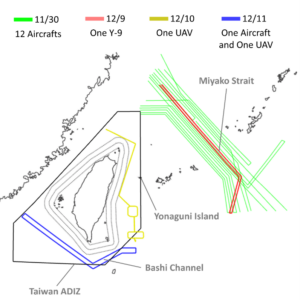
(Source: Compilation by RCDA Based on Press Releases of ROC MND and Japan’s Ministry of Defense Joint Staff)
The December training drill also carries strategic significance. It demonstrates the PLA’s capacity to project combat power simultaneously to the surrounding waters of the First Island Chain to the incoming US administration, even if available sources cannot prove this to have been the PLA’s intention. The PLAN forces involved in the training drills have reached a level capable of rivaling the US Seventh Fleet—the largest forward-deployed US fleet, based in Japan—which typically operates with approximately 50–70 surface ships and submarines (USINDOPACOM, January 23, 2021). The United States benefits from the cooperative combat capabilities of regional navies, but the PRC can leverage its land-based long-range missile strike capabilities, particularly its medium-range anti-ship ballistic missiles, to significantly enhance the PLA’s far-sea area-denial operational capacity.
The PRC’s demonstration of its capacity to deploy so many naval vessels around the First Island Chain extends beyond weaponry and combat capabilities to also include logistical support. For the PLAN to deploy 60 warships for training drills lasting a week requires logistics units to ensure the ships are prepared for deployment, maintain operational readiness before the drills, and handle post-mission servicing and repairs upon returning to port.
Conclusion
Beijing’s recent drills around Taiwan and the First Island Chain were intended to demonstrate that its navy’s overall operational capacity under current normal conditions has reached a level in the Western Pacific comparable to that of the United States. While the training drills did not amount to a full joint exercise on the scale of other activities this year, they nevertheless involved a significant number of vessels operating for a sustained period. The unusual timing of the drills suggests that they may have been intended to signal the PLA’s power projection capacity to the incoming US administration.
Notes
[1] For more on Joint Sword, see China Brief, May 5, 2023; July 26; October 18; November 1.
[2] These figures exclude sorties in airspace further away from Taiwan.
[3] For more related assessments, see Pacnet Commentary at Pacific Forum, September 23.




